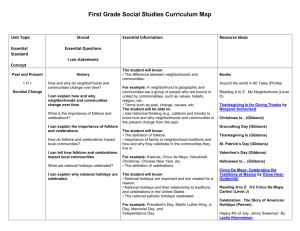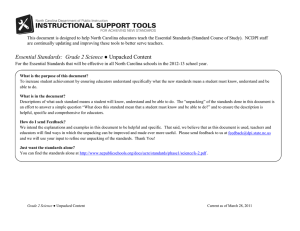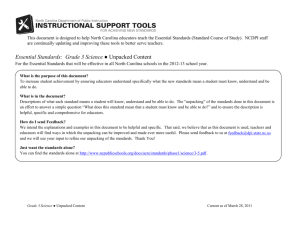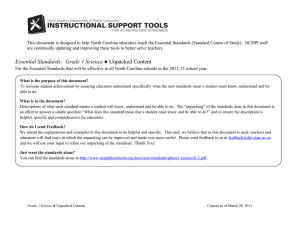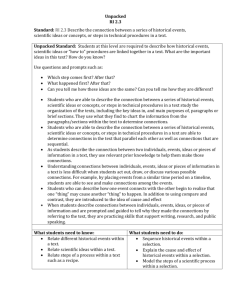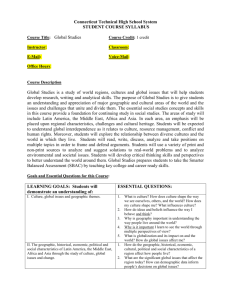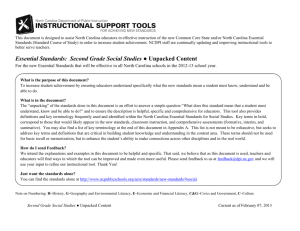Document 10710718
advertisement
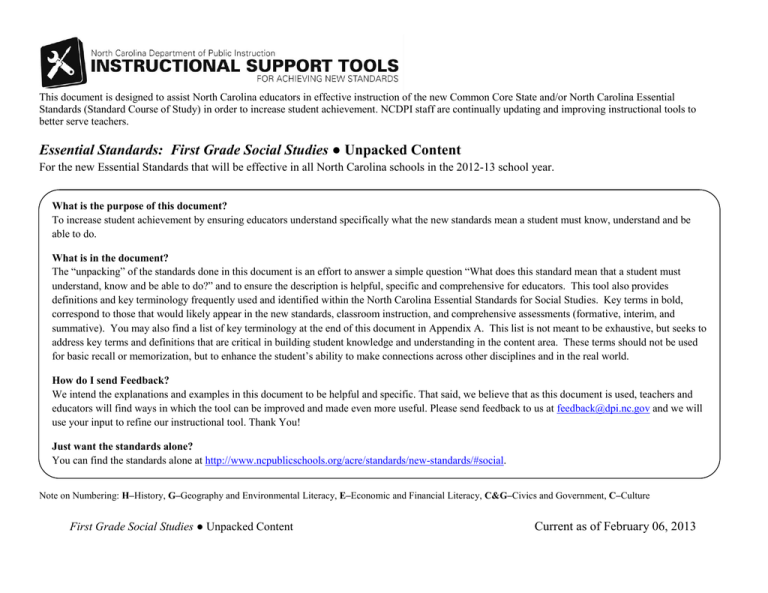
This document is designed to assist North Carolina educators in effective instruction of the new Common Core State and/or North Carolina Essential Standards (Standard Course of Study) in order to increase student achievement. NCDPI staff are continually updating and improving instructional tools to better serve teachers. Essential Standards: First Grade Social Studies ● Unpacked Content For the new Essential Standards that will be effective in all North Carolina schools in the 2012-13 school year. What is the purpose of this document? To increase student achievement by ensuring educators understand specifically what the new standards mean a student must know, understand and be able to do. What is in the document? The “unpacking” of the standards done in this document is an effort to answer a simple question “What does this standard mean that a student must understand, know and be able to do?” and to ensure the description is helpful, specific and comprehensive for educators. This tool also provides definitions and key terminology frequently used and identified within the North Carolina Essential Standards for Social Studies. Key terms in bold, correspond to those that would likely appear in the new standards, classroom instruction, and comprehensive assessments (formative, interim, and summative). You may also find a list of key terminology at the end of this document in Appendix A. This list is not meant to be exhaustive, but seeks to address key terms and definitions that are critical in building student knowledge and understanding in the content area. These terms should not be used for basic recall or memorization, but to enhance the student’s ability to make connections across other disciplines and in the real world. How do I send Feedback? We intend the explanations and examples in this document to be helpful and specific. That said, we believe that as this document is used, teachers and educators will find ways in which the tool can be improved and made even more useful. Please send feedback to us at feedback@dpi.nc.gov and we will use your input to refine our instructional tool. Thank You! Just want the standards alone? You can find the standards alone at http://www.ncpublicschools.org/acre/standards/new-standards/#social. Note on Numbering: H–History, G–Geography and Environmental Literacy, E–Economic and Financial Literacy, C&G–Civics and Government, C–Culture First Grade Social Studies ● Unpacked Content Current as of February 06, 2013 History Essential Standard: 1.H.1 Understand that history tells a story of how people and events changed society over time. Concept(s): Change, Community, Culture Clarifying Objectives Unpacking 1.H.1.1 Explain how and why neighborhoods and communities change over time. What does this standard mean a student will understand, know and be able to do? The student will understand: Changes occur in a community over time due to economic, political, cultural, or environmental factors. Changes in neighborhoods and communities can reflect historical events. The student will know: The factors that lead to change in neighborhood or community. The difference between neighborhoods and communities. For example: A neighborhood is geographic and communities are a group of people who are bound or united by commonalities, such as values, beliefs, religion, etc. Terms such as past, change, causes, etc. The student will be able to: Use historical thinking to tell a story of how and why a neighborhood and community can change (from the past to the present). For example: types of businesses, landscape, jobs, transportation, population, etc. Key Terminology: Historical thinking- a set of reasoning skills that students of history should learn as a result of studying history that enable students to interpret, analyze and use information about past events. First Grade Social Studies ● Unpacked Content Page 2 of 12 Current as of February 06, 2013 1.H.1.2 Explain the importance of folklore and celebrations and their impact on local communities. The student will understand: Folklore and celebrations may originate from historical references and events. Folklore and celebrations may influence the norms and traditions of local communities. For example: rights of passage for children, holiday celebrations, stories used to teach lessons . The importance of folklore and celebrations is often derived from their origins. The student will know: The definition of folklore and celebrations. Examples of folklore and celebrations and their histories. How and why families celebrate in their communities. For example: Eid al-Fitr, Kwanza, Cinco de Mayo, Yom Kippur, Christmas, Chinese New Year, etc. 1.H.1.3 Explain why national holidays are celebrated (Constitution Day, Independence Day, Martin Luther King, Jr., Memorial Day, Presidents’ Day, etc.). The student will understand: National holidays are often celebrated to honor people and events significant to a people’s culture and/or history. National holidays, traditions, places and people help to provide identity for the community and nation. For example: July 4th parades celebrate our nation’s independence, Juneteenth Day is to celebrate the Emancipation Proclamation, Memorial Day is to remember soldiers who died and people have special services, Native American Heritage Day is a day of recognition for the significant contributions the first Americans made to the establishment and growth of the U.S. National holidays often reflect an event that has patriotic significance in a people’s history. The student will know: Definitions of the terms patriotic and national. National holidays are important and are created for a historical and cultural reasons. First Grade Social Studies ● Unpacked Content Page 3 of 12 Current as of February 06, 2013 National holidays are related to traditions and celebrations in the United States. The difference between national (federal) and religious holidays. The different national patriotic holidays celebrated. For example: President’s Day, Martin Luther King, Jr. Day, Memorial Day, and Independence Day. Geography and Environmental Literacy Essential Standard: 1.G.1 Use geographic representations, terms and technologies to process information from a spatial perspective. Concept(s): Location, Physical Characteristics Clarifying Objectives Unpacking 1.G.1.1 Use geographic tools to identify characteristics of various landforms and bodies of water. What does this standard mean a student will understand, know and be able to do? The student will understand: Land and water may be exhibited differently depending on the geographic representation used. The student will know: Geographic tools are used to identify and describe the physical features of landforms and bodies of water. For example: The ocean is a large body of water and a mountain is a landform. Examples of geographic tools such as maps globes, and atlases (e.g., paper and electronic forms), global positioning systems (e.g., GPS), keys, legends, compass rose, etc. Geographic terminology that is used on maps, globes, and other tools. Maps and globes are different geographic representations of Earth. The student will be able to: Create simple maps showing landforms and bodies of water. Use geographic terms in work and play to describe and find places. First Grade Social Studies ● Unpacked Content Page 4 of 12 Current as of February 06, 2013 1.G.1.2 Give examples showing location of places (home, classroom, school and community). The student will understand: Using absolute location often makes it easier to determine a specific place or direction. Using relative location to provide directions may present challenges. The student will know: The difference between absolute and relative location. Maps and other geographic tools are used to locate familiar contexts of home, classroom, school and community and absolute and relative location. People use geographic terms, tools, and technology in work and play to describe and find absolute and relative locations and places. For example: Maps are used to find unfamiliar places and compasses are used to find direction, etc. The student will be able to: Find specific locations of places on a map such as home, classroom or playground by using map symbols and giving directions. 1.G.1.3 Understand the basic elements of geographic representations using maps (cardinal directions and map symbols). The student will understand: Basic elements of geographic representations can be used to find locations of places. The student will know: Symbols represent features on a map. Elements of cardinal directions, map symbols, etc. are tools that are used on maps to find locations of places. The student will be able to do: Identify and use map symbols to represent streets, roads, lakes, etc. Create and interpret a basic map including the key with symbols from the map. First Grade Social Studies ● Unpacked Content Page 5 of 12 Current as of February 06, 2013 Essential Standard: 1.G.2 Understand how humans and the environment interact within the local community. Concept(s): Change, Human-Environment Interaction, Natural Resources Clarifying Objectives 1.G.2.1 Explain ways people change the environment (planting trees, recycling, cutting down trees, building homes, building streets, etc.). Unpacking What does this standard mean a student will understand, know and be able to do? The student will understand: The physical environment does not always stay the same due to human-environment interaction. People can change the environment through the use of natural resources. The student will know: Ways people change the environment to meet their needs. For example: the use of land, building of homes, and ecosystems, etc. 1.G.2.2 Explain how people use natural resources in the community. Examples of natural resources. The student will understand: The environment often provides many natural resources for people to live. For example: fish from the sea and grain from farms. The student will know: Ways people use, conserve, and waste natural resources in their community. Examples of basic natural resources include air, water, sunlight, animal, minerals, wildlife, coal, sand, and many more. Natural resources are most always found in or on the earth. 1.G.2.3 Explain how the environment impacts where people live (urban, rural, weather, transportation, etc.). The student will understand: Different environments will help determine the particular location and choices of a group of people. The student will know: People live in environments that are conducive to their living wants and needs whether it is weather conditions, ways of travel, city or country, etc. First Grade Social Studies ● Unpacked Content Page 6 of 12 Current as of February 06, 2013 Examples of environmental characteristics that impact where and how people live. For example: People who live in the city may travel on public transportation such as a city bus, etc. Economics and Financial Literacy Essential Standard: 1.E.1 Understand basic economic concepts. Concept(s): Goods and Services, Supply and Demand, Choice, Resources, Wants and Needs Clarifying Objectives Unpacking 1.E.1.1 Summarize the various ways in which people earn and use money for goods and services. What does this standard mean a student will understand, know and be able to do? The student will understand: People often depend on jobs and other sources of income so they can contribute to the production and exchange of goods and services. Choice is integral to earning and using money for goods and services. The student will know: Ways people use money they earn to buy goods and services. Individuals earn income by working for various businesses. How to distinguish between goods and services. Individuals receive income by working at a job. The difference between income and money. People make decisions about jobs based on education, skills, interests, etc. The student will be able to: Summarize various examples of people earning, saving, and spending money for goods and services. First Grade Social Studies ● Unpacked Content Page 7 of 12 Current as of February 06, 2013 1.E.1.2 Identify examples of goods and services in the home, school and community. The student will understand: Producers and consumers may dictate the distribution and availability of goods and services. Goods and services are determined by the availability of resources. The student will know: Goods are food, clothing, supplies, etc. Service providers are firemen, policemen, lawn maintenance caretakers, banks, etc. The difference between goods and services. Examples of resources Examples of goods and services. 1.E.1.3 Explain how supply and The student will understand: demand affects the choices families and Supply and demand impact decisions families and communities make about goods and communities make. services. The levels of supply and demand can be dictated by scarcity of goods and services. The student will know: The process of making choices using available resources and why people cannot have everything they want. People often prioritize choices based on wants and needs. Examples of goods and services. The definition of supply and demand. Note: Law of Supply- if demand is held constant, an increase in supply leads to a decreased price, while a decrease in supply leads to increased price. Key Terminology: Supply-the quantities of a good or service that a firm is willing and able to make available for sale at different prices (economic concept of supply and demand). Demand-the desire and ability of individuals to purchase economic goods or services at the market price; along with supply, one of the two key determinants of price. http://www.michigan.gov/documents/10-02Glossary_48851_7.pdf First Grade Social Studies ● Unpacked Content Page 8 of 12 Current as of February 06, 2013 Civics and Government Essential Standard: 1.C&G.1 Understand the importance of rules. Concept(s): Citizenship, Authority, Conflict, Fairness, Order, Rules, Rights, Responsibilities Clarifying Objectives Unpacking 1.C&G.1.1 Explain why rules are needed in the home, school and community. What does this standard mean a student will understand, know and be able to do? The student will understand: Rules are needed to promote fairness and manage conflict in the home, school and community. Rules are needed to maintain order in the home, school and community. The student will know: How rules ensure a safe society in the home, school and community. For example: respect for the rights of others, following rules, and getting along with others, etc. 1.C&G.1.2 Classify the roles of authority figures in the home, school and community (teacher, principal, parents, mayor, park rangers, game wardens, etc). How to distinguish appropriate rules and consequences and why they are used. The importance of home, school and community rules to a society. The student will understand: Authority figures in the home, school, and community influence the well being of people through creating and enforcing rules.. The student will know: The roles and responsibilities of people with authority in home, school and community. For example: teachers, principal, parents, mayor, park rangers, wardens, etc. First Grade Social Studies ● Unpacked Content Page 9 of 12 Current as of February 06, 2013 Notable authority leaders of home, school and community. For example: to include but not limited to teacher, principal, parents, mayor, park rangers, game wardens, law enforcement, etc. The student will be able to: Classify different types of authority figures according to their roles and responsibilities in the home, school, and community. 1.C&G.1.3 Summarize various ways in which conflicts could be resolved in homes, schools, classrooms and communities. The student will understand: Conflicts are often solved through communication and cooperation. The student will know: There are various ways to solve differences in conflicts. Examples of way to resolve conflict. Conflicts might be settled in fair and just ways in homes, schools, classrooms and communities (e.g., majority rules). Two of the various ways that individuals, groups, and communities manage conflict and promote equality, justice and responsibility in homes, schools, classrooms and communities are communication and cooperation. The student will be able to: Summarize ways in which conflicts between people can be resolved. Culture First Grade Social Studies ● Unpacked Content Page 10 of 12 Current as of February 06, 2013 Essential Standard: 1.C.1 Understand the diversity of people in the local community. Concept(s): Culture, Values & Beliefs, Diversity Clarifying Objectives Unpacking 1.C.1.1 Compare the languages, traditions, and holidays of various cultures. What does this standard mean a student will understand, know and be able to do? The student will understand: People’s lives are often shaped by different values and traditions. Diverse languages, traditions and holidays may contribute to the development of a people’s values and beliefs. The student will know: Individual differences in languages, beliefs and customs that may be unique to one’s culture. Comparisons of the beliefs, customs, ceremonies, traditions and social practices of the varied cultures in their local community. Comparisons of how people from other cultures live, work and play. Similarities and differences in the ways various cultures address human needs and concerns. 1.C.1.2 Use literature to help people understand diverse cultures. The student will understand: Literature often illustrates the values and beliefs of diverse cultures. Literature often reveals the origins of a culture’s values and beliefs. The student will know: How exposure to other cultures through literature can promote cultural awareness and tolerance. Examples of literature, art and music in diverse cultures. APPENDIX A: KEY TERMINOLOGY First Grade Social Studies ● Unpacked Content Page 11 of 12 Current as of February 06, 2013 History: Historical thinking- a set of reasoning skills that students of history should learn as a result of studying history that enable students to interpret, analyze and use information about past events. Folklore- consists of legends, music, oral history, jokes, popular beliefs, fairy tales and customs that are traditions of that culture or group. Economics and Financial Literacy: Supply-the quantities of a good or service that a firm is willing and able to make available for sale at different prices (economic concept of supply and demand). Demand-the desire and ability of individuals to purchase economic goods or services at the market price; along with supply, one of the two key determinants of price. First Grade Social Studies ● Unpacked Content Page 12 of 12 Current as of February 06, 2013
